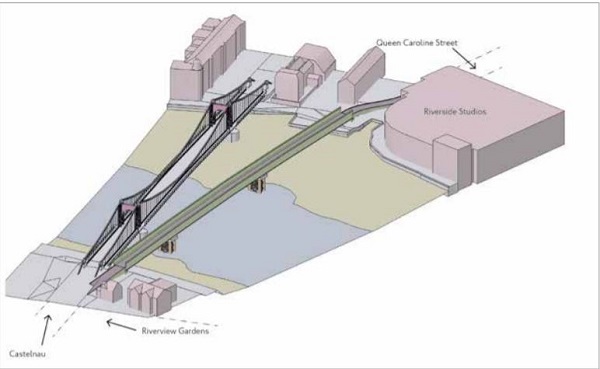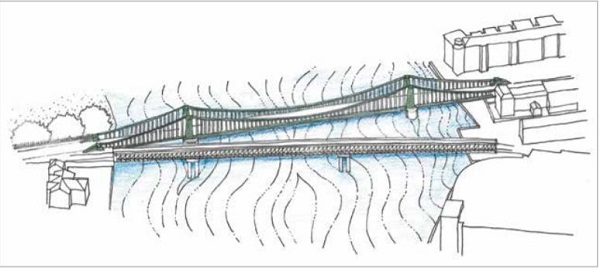Temporary Hammersmith Bridge Survives TfL Capital Spending Cuts
No funding for permanent replacement and Piccadilly line signalling

CGI of the proposed temporary bridge
Details of planned capital spending by Transport for London (TfL) shows that the temporary foot and cycle bridge by Hammersmith Bridge is one of a limited number of projects which have survived in a much reduced programme.
The temporary bridge is a seven metre-wide, prefabricated steel structure, supported by two piers in the river. The bridge would be step free, with a 5.5 metre-wide surface for people walking and cycling. Access would be by shallow ramps from Queen Caroline Street on the north bank and from close to the junction of Castelnau and Riverview Gardens on the south bank. TfL would need planning permission from both Richmond and Hammersmith & Fulham councils and a decision was originally anticipated this summer.
The project to repair Hammersmith Bridge has been identified as safety critical and has been authorised to continue during the Government's current social distancing measures. However, only preparatory work can be done without funding to complete the work being in place. There is no mention of funding being made available for a permanent replacement which would be able to take motor vehicles.
In addition the much delayed signalling upgrade on the Piccadilly line has no funding earmarked for it and will be dependent on central government support if it is to proceed.
 Artist's impression of temporary bridge
Artist's impression of temporary bridge
The Northern line extension, Tube station upgrades will all continue and Ultra Low Emission Zone expansion will also restart.
Chief finance officer Simon Kilonback has said that TfL must “completely overhaul” its business plan because of the coronavirus pandemic as the network stands to lose up to £4 billion of income this financial year – and warned of long-term consequences for transport investment in the capital.
Half a billion pounds of TfL upgrades will now be delayed in 2020/21, he said.
Mayor of London Sadiq Khan has branded the cuts a “false economy” forced on London by the Government.
TfL has been hit hard by the Covid-19 outbreak, with 90 per cent of fare revenue evaporating during lockdown as passenger numbers dropped.
Tube journeys fell 95 per cent when coronavirus lockdown began, with bus journeys down 85 per cent.
The network secured an eleventh hour bailout from the Government last month, just hours before it ran out of cash.
This £1.6 billion funding injection will keep trains and buses running until October – but the Mayor has warned the deal is a “sticking plaster”.
TfL officers set out emergency budget plans at a virtual board meeting this Monday (2 June) – with £500 million of planned investment now set to be delayed.
More than 300 projects across London were paused as the impact of the outbreak became clear, Mr Kilonback said.
But most building schemes on TfL’s books will continue – because the price of scrapping construction or cancelling contracts outweighs any savings, the finance boss explained.
The network will also prioritise plans to widen pavements and build temporary cycle lanes, so commuters can avoid public transport while the Covid-19 outbreak continues.
But TfL’s overall investment will be cut this year – despite the fact that national train line upgrades funded by Network Rail are currently increasing.
TfL boss Mike Brown said it was a “massive irony” that London is losing out on cash because of “the different relationship we appear to have with central Government”.
And the Mayor warned cutting capital investment in London transport is a “false economy”.
“The Government should be looking for shovel-ready projects and a stimulus,” Mr Khan said.
“I can’t think of a better stimulus than investing in capital in the capital.”
Written with contributions from Jessie Matthewson - Local Democracy Reporter
June 4, 2020